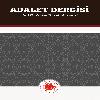Sayısal Delilin Değiştirilemezliğinin Sağlanmasının Yolu Olarak Özet Değer Kavramı ve Özet Değer Çakışması
delil, sayısal delil, özetleme, ispat, özet değer çakışması.
THE CONCEPT OF HASH VALUE AND THE COLLISION OF HASH VALUE AS THE WAY TO PROVIDE UNASSAILABILITY OF DIGITAL EVIDENCE
evidence, digital evidence, hashing, proof, collision of hash value. delil, sayısal delil, özetleme, ispat, özet değer çakışması.,
___
- Aydın D, Ceza Muhakemesinde Deliller, Yetkin Publications, Ankara, 2014.
- Bıçak V, Suç Muhakemesi Hukuku, 4th Edition, Seçkin Publications, Ankara, 2018.
- Casey Eoghan, “Reconstruction Digital Evidence”, in: Crime Reconstruction, Edited by W. Jerry Chisum – Brent E. Turvey, 2006.
- Centel N / Zafer H, Ceza Muhakemesi Hukuku, 14th Edition, Beta Publications, İstanbul, 2017.
- Chisum W B / Turvey B E, Crime Reconstruction, Academic Press, 2007, s. XV.
- Cumhur Ş, Ceza Muhakemesinde İspat (Delillerin Doğrudan Doğruyalığı İlkesi), Yetkin Publications, Ankara, 2001.
- Daniel L / Daniel L, Digital Forensics for Legal Professionals Understanding Digital Evidence From The Warrant To The Courtroom, Syngress, USA, 2012.
- Değirmenci O, “Bilgi Toplumunun Delil Türü: Sayısal Delil ve Bilimselliği”, Vol. 9, No. 97, Terazi Law Journal, Septermber, 2014, ss. 14 – 28.
- Değirmenci O, Ceza Muhakemesinde Sayısal (Dijital) Delil, Seçkin Publications, Ankara, 2014.
- Digital Evidence in the Courtroom: A Guide for Preparing Digital Evidence for Courtroom Presentation, The National Center for Forensic Science, 2003, http:/www.ncfs.org/DE_courtroomdraft.pdf, accessed: 10.09.2011.
- Doğan K, Ceza Muhakemesinde Belirsizlik Kuşkudan Sanık Yararlanır İlkesi “in dubio pro reo”, Seçkin Publications, Ankara, 2016.
- Erdem B/Işıtman N M, Basic Legal Documents of Turkish Criminal Law, Seçkin Publications, Ankara, 2021.
- Eryılmaz A, Ceza ve Disiplin Hukukunda Hukuka Aykırı Delil, HUKAB Publications, Ankara, 2013.
- Feyzioğlu M, Ceza Muhakemesinde Vicdani Kanaat, Ankara, 2002.
- Gedik D, Öğreti ve Yargısal İçtihatlar Işığında Ceza Muhakemesinde Şüpheden Sanık Yararlanır İlkesi (In Dubio Pro Reo), Adalet Publications, 2016.
- Harrington M, “A Methodology for Digital Forensic”, Vol. 7, 2004, T.M. Cooley J. Parc. & Clinical L.
- Hoffman S, “An Illustration of Hashing and Its Effect on Illegal File Content in the Digital Age”, Vol. 22, No. 4, Intellectual Property & Technology Law Review, April 2010, ss. 6 – 14.
- Hoffmann M, “Arguing for Suppression of ‘Hash’ Evidence”, May 2009, The Champion.
- Hricik D, “The Transmission and Receipt of Invisible Confidential Information”, http//www.hricik.com/eethics/Metadata1103.doc, accessed: 06 Ocak 2013.
- http://thinkexist.com/quotes/susan_brenner/, accessed 01 February 2014.
- https://md5.hesaplama.net/hesaplama.do, accessed 05 Aralık 2017.
- Israel A, “To Scrub or Not to Scrub: The Ethical Implications of Metadata and Electronic Data Creation, Exchange, and Discovery, Vol. 60, 2009, Alabama Law Review.
- Jekot W, “Computer Forensics, Search Strategies, and the Particularity Requirement”, Vol. VII, Spriing 2007, Pittsburgh University Journal of Technology Law and Policy, https://doi.org/10.5195/tlp.2007.29.
- Koca M, “Ceza Muhakemesi Hukukunda Deliller”, Vol. 1, Nu. 2, December 2016, Journal of Criminal Law, ss. 207 – 225.
- Kruse W G/Heise J G, Computer Forensic: Incident Response Essentials, 2002.
- Kunter N, Ceza Muhakemesi Hukuku, Revised and Enhanced 4th Edition, İstanbul, 1970.
- Larkin J E D, “Compelled Production of Encrypted Data”, Vol. 14, Number 2, Winter 2012, Vanderbilt Journal of Entertainment and Technology Law, ss. 253 – 278.
- Maghaireh A M S, Jordanian Cybercrime Investigations: A Comparative Analysis of Search for and Seizure of Digital Evidence, Thesis Submitted in Fulfilment of the Requirements for the Award of the Degree, University of Wollonong 2009.
- Mendel F/Pramstaller N/Rechberger C/Kontak M/Szmidt J, “Cryptanalysis of the GOST Hash Function”, in: CRYPTO 2008, LNCS 5157 (Ed. D. Wagner), Springer 2008, ss. 162 – 178.
- Nedir Bu Adli Bilimler/Kimdir Bu Adli Bilimciler, Adli Bilimciler Derneği Yayını, Ankara, 2019.
- Newby T/Schwarz J M, “Rethinking The Storage of Computer Evidence”, UNAFEI Resource Material Series No. 79, December 2009, Tokyo.
- Robinton L R, “Courting Chaos: Conflicting Guidance from Courts Highlights The Need for Clearer Rules to Govern the Search and Seizure of Digital Evidence”, Vol. 12, 2010, Yale Journal of Law and Technology, ss. 311 – 147.
- Roxin C, “İspat Hukukunun Esasları”, Translator Yener Ünver, Y. 4, No. 8, Fall 2005, İstanbul Ticaret Üniversitesi Sosyal Bilimler Dergisi, ss. 265 – 289.
- Schuck C M, “A Search for the Caselaw to Support the Computer Search ‘Guidance’ in United States v. Comprehensive Drug Testing”, Vol. 16, No. 2, 2012, Lewis & Clark Law Review, ss. 741 – 781.
- Selçuk S, “Temyiz Denetiminin Sınırları ve Bu Sınırlara Uymamanın Kaçınılmaz Sancılı Sonuçları/Açmazları/Tehlikeleri”, Vol. 19, No. 2, 2013, Marmara Üniversitesi Hukuk Araştırmaları Dergisi, Prof.Dr. Nur Centel’e Armağan, ss. 319 – 361.
- Sommer P, “Downloads, Logs and Captures: Evidence from Cyberspace”, Vol. 5, Journal of Financial Crime.
- Sutton D, “Computer Forensics and Child Pornography Investigations”, Vol. 2, 2011, Stevenson University Forensics Journal.
- Şahin C/Göktürk N, Ceza Muhakemesi Hukuku – II, Revised and Updated 8th Edition, Seçkin Publications, Ankara, 2019.
- Thompson E, “MD5 Collisions and the Impact on Computer Forensics”, Vol. 2, 2005, Digital Investigation, ss. 36 – 40.
- Tosun Ö, Türk Suç Muhakemesi Hukuku Dersleri Vol.:1, İstanbul, 1984.
- Türkbağ A U, “Hukuka Gerçekçi Eleştirel Bakış: Hukuk Sosyolojisi”, Issue 16, 2008/1, Sosyoloji Dergisi, 3rd Series, s. 43 – 54.
- Uzunay Y/Koçak M, “Bilişim Suçları Kapsamında Dijital Deliller”, Academic Informatics Conference, Gaziantep, February 2005.
- Yayla M, Ceza Muhakemesi Hukukunda İspat ve Şüphe, Seçkin Publications, Ankara, 2016.
- ISSN: 1011-730X
- Yayın Aralığı: 2
- Başlangıç: 2019
- Yayıncı: ADALET BAKANLIĞI EĞİTİM DAİRESİ BAŞKANLIĞI
İSPAT YÜKÜNÜ TERSİNE ÇEVİREN KANUNİ KARİNELERİN MASUMİYET KARİNESİ BAĞLAMINDA DEĞERLENDİRİLMESİ
Miray ÖZER DENİZ, Erman EKİNGEN
KOLOMB’TAN MÜLTECİLERE 1492-1850 AVRUPASI VE BUGÜNÜN GÜVENLİK HAKKI OLMAYAN ÖZNELERİ
UYGUR HUKUK VESİKALARI ÜZERİNE TÜRKÇE LİTERATÜRÜN HUKUKİ TAHLİLİ
Numan DOĞAN, Ahmet Hulusi AKKAŞ
BİLİRKİŞİLİK ŞİRKETLERİNİN TİCARET HUKUKU AÇISINDAN DEĞERLENDİRİLMESİ
ANLAŞMALI BOŞANMA BİR ÇEKİŞMESİZ YARGI İŞİ MİDİR?
